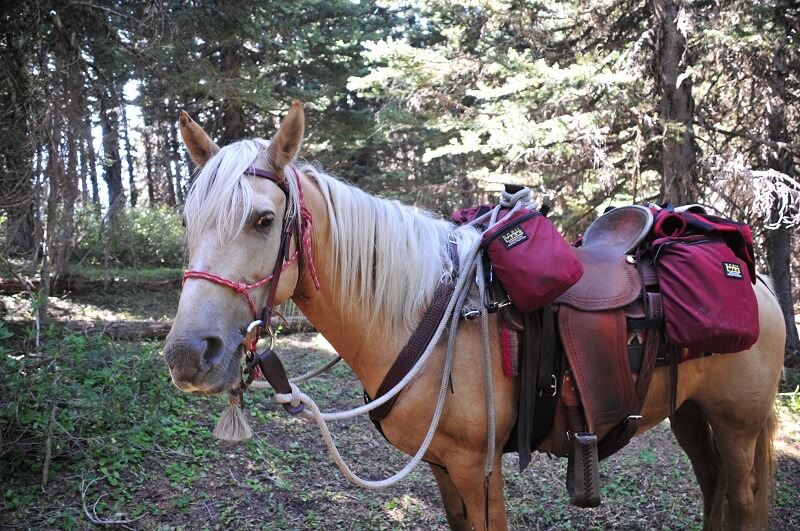Tips for Solo Camping in the Backcountry
By Robert Eversole
An overnight trip with just your trail horse is simple — if you plan carefully.
For many people, camping with horses evokes images of pack mules, canvas tents, and the smells of Dutch oven cooking wafting through a pine-scented meadow. But the reality is that most horse owners don’t have the pack animals needed to haul in all the gear to make this picture a reality. There’s an alternative: lightweight camping directly off of your riding stock.
 For me, the most important thing to remember is that single horse camping should be an enjoyable experience for both you and your horse or mule. That means you may have to leave behind some of the luxury items we’ve become accustomed to when trailhead camping out of our trailers.
For me, the most important thing to remember is that single horse camping should be an enjoyable experience for both you and your horse or mule. That means you may have to leave behind some of the luxury items we’ve become accustomed to when trailhead camping out of our trailers.
Let’s look to backpackers for inspiration. With this type of low-weight and volume gear, you’ll be able to pack all of the essentials for a comfortable trip in just a set of saddle and horn bags.
Preparation
Where to go? Not all areas are suitable for single horse camping. When a horse is packing you plus all of your camp, it’s impractical to carry equine feed or water. For that reason, we must plan our solo trips around good grazing and reliable water sources. Research your trip prior to leaving home so you’ll know that what type of forage is available. If grazing isn’t available it’s best to find another destination.
You can find places to go in a variety of ways— on the web at www.TrailMeister.com, or ask local chapters of the Back Country Horsemen of America; they’ve been there, done that!
Ensure that you and your animal are both ready for the adventure. You will need to condition for long days on the trail and understand what it’s like to be away from other people and horses. My first camping trip of every year happens at home in the back pasture. Keeping our initial trip close to home lets me sort out any issues before we’re 20 miles into the backcountry where a mistake can have larger consequences.
Skills to Know
How to set up a highline: www.trailmeister.com/ingredients-for-highline-success
Emergency skills: www.trailmeister.com/4-things-can-save-life-horse-riding
Equipment
When backcountry camping with a single horse, prioritize lightweight and low-volume items that multitask. Minimizing what you carry into the backcountry allows you to maximize your riding experiences.
Over the past years I’ve worked on reducing my impact on multi-day outings while staying safe and comfortable – without over-tasking my horse. Careful planning and gear selection can result in a base weight (weight of camping gear without tack and food) of less than 15 pounds.
Look to the backpacking community for examples of featherlight shelters. You can find tents that weigh less than 10 pounds. I like the Solo Shelter by 5 Owls for its durability. I’ve also taken to the trees and used hammocks for a great night’s sleep. Modern camping hammocks weigh less than a pound and compress smaller than a softball when packed. My main sleep/shelter system consists of a hammock, down sleeping bag rated to 30 degrees, insulating pad, and tarp for rain. This system weighs just under 5 pounds and packs easily into a cantle bag.
On the Trail
Keep the weight over the shoulders. Equines carry weight over their shoulders better than behind the saddle, so the heaviest items go in your horn bags. Lightweight items such as sleeping bags live in the cantle bag. Other light items, cook stove, dehydrated food, etc. live in the saddle bags. In a perfect world you’ll have a friend going with you who can share some items.
I use the cavalry’s rule of thumb and try not to ask my riding animal to carry more than 20% of its weight, including rider and tack. This is very hard to do, and I’ll admit that often I’m pushing 30%. So I try to be as considerate as I can by keeping my heavy hauling days short and getting off to walk now and then to give my beast a break. I also use a use a scale to weigh all of my packed equipment.
When you’re loading your animal think about getting on and off. Bathroom breaks happen and you want to be able to actually swing your leg over your gear. I often see people that can barely get on and off their horse packed with big, bulky loads. In an emergency this can be dangerous. Important: be sure the weight of your load is evenly distributed on both sides of your horse.
Before You Go
Once all the preparations have been made take one additional moment to leave your trip agenda with a responsible person. Here’s what I leave with my wife, so she knows where I’m going, when I plan to be back and what to do in case of an emergency: www.trailmeister.com/trail-ride-itinerary.
You can explore new country, and see amazing sights without hiking in. For more information on trail riding and horse camping visit www.TrailMeister.com, the world’s largest guide to horse trails and camps.
Published September 2019 Issue

Robert Eversole, ”the trail meister,” owns www.TrailMeister.com, the largest database of horse riding and camping areas in the U.S. with free trail and trailhead information, trail maps, and much more to help horse enthusiasts experience the joys of trail riding. Robert is a registered riding instructor with PATH International, a mounted search and rescue team member, and a U.S. Marine who has served on the board of the Backcountry Horsemen of Washington (BCHW). He is enjoying his new career helping fellow trail riders stay found and safe on the trail. When not on the trail, The Trail Meister resides near Spokane, WA and teaches land navigation to a wide variety of outdoor groups across the nation. For North America’s largest horse trail and camping directory, trail tips, and more, visit www.TrailMeister.com.






